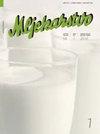以蜡样芽孢杆菌产毒基因为重点的乳制品微生物质量和安全性评价
IF 1.1
4区 农林科学
Q3 AGRICULTURE, DAIRY & ANIMAL SCIENCE
引用次数: 3
摘要
尽管乳制品在人类营养中发挥着重要作用,但它们可能会给消费者带来风险。本研究旨在确定所选乳制品中与蜡样芽孢杆菌肠毒素基因有关的微生物污染水平。从埃及法尤姆省不同地区的零售市场随机收集了300份植物来源的调味奶酪、调味酸奶、调味饮用酸奶、kareish(脱脂乳奶酪)、软奶酪和Ras(Romy)奶酪(各50份样本)。应用多重PCR对蜡样芽孢杆菌进行微生物分析和分子鉴定,揭示了与食用受试乳制品(白干酪、Ras干酪和kareish干酪)相关的潜在风险。在所有分析的奶酪(白干酪、Ras干酪和kareish干酪)中,检测到凝固酶阳性葡萄球菌(20.0%、22.0%和20.0%)和大肠菌群(76.0、86.0和88.0%)的高污染水平。在卡雷什奶酪样品中发现的真菌比例最高(78.0%)。地衣芽孢杆菌是在kareish奶酪(23.7%)和调味饮用酸奶(17.0%)样品中检测到的最多的需氧孢子形成细菌。在调味饮用酸奶和白软奶酪样品中,蜡样芽孢杆菌的患病率最高(8.0%)。(nhe)是所有检测样本中检测最多的基因(100.0%)。除调味饮用酸奶样品外,所有研究样品的nhe和ces基因之间均存在显著差异(p<0.05)。未检出沙门氏菌、大肠杆菌和铜绿假单胞菌。这项调查是为数不多的描述植物风味奶酪和风味饮用酸奶安全和质量状况的调查之一,尤其是在埃及。本文章由计算机程序翻译,如有差异,请以英文原文为准。
Evaluation of microbial quality and safety of selected dairy products with special focus on toxigenic genes of Bacillus cereus
Although dairy products play a significant role in human nutrition, they may cause a risk to the consumers. This study intends to determine the microbial contamination level in selected milk products concerning Bacillus cereus enterotoxigenic genes. Three hundred plant-origin flavoured cheese, flavoured yogurt, flavoured drinking yogurt, kareish (skim milk cheese), soft cheese, and Ras (Romy) cheese (50 samples for each) were randomly collected from retail markets at different districts in El Fayoum Governorate, Egypt. The microbiological analysis and the molecular identification of Bacillus cereus by multiplex PCR were applied and revealed potential risks associated with consumption of the tested milk products (white soft, Ras, and kareish cheeses). In all analysed cheeses (white soft, Ras and kareish) a high contamination level with coagulase positive staphylococci (20.0 %, 22.0 % and 20.0 %) and coliform bacteria (76.0, 86.0, and 88.0 %) was detected. The highest percent (78.0 %) of fungi was found in kareish cheese samples. Bacillus licheniformis was the most aerobic spore forming bacteria detected in kareish cheese (23.7 %) and flavoured drinking yogurt (17.0 %) samples. The highest prevalence (8.0%) of Bacillus cereus was recorded in the flavoured drinking yogurt and white soft cheese samples. The (nhe) was the most detected gene (100.0 %) in all of the examined samples. There was a significant difference (p<0.05) between nhe and ces genes in all investigated samples except in flavoured drinking yogurt samples. Salmonella sp., Escherichia coli and Pseudomonas aeruginosa were not detected. This survey is one of the very few surveys that describe the safety and quality status of plant-origin flavoured cheeses and flavoured drinking yogurt, particularly in Egypt.
求助全文
通过发布文献求助,成功后即可免费获取论文全文。
去求助
来源期刊

Mljekarstvo
Agricultural and Biological Sciences-Animal Science and Zoology
CiteScore
1.90
自引率
41.70%
发文量
18
审稿时长
12 weeks
期刊介绍:
Mljekarstvo is an open access, peer-reviewed international quarterly scientific journal. The first issue was published in 1951, by the Croatian Dairy Operators'' Association (today: Croatian Dairy Union, publisher). In a paper at a Union conference held 28 October 1951 in Zagreb it was said: "Our desire is that this magazine does not meet the fate of its predecessors, but that it continues to reflect the creative efforts and to provide guidelines for the producers as well as all other operators employed in the dairy industry."
It is our pleasure today to say that wishes of the enthusiasts who attended the conference have come true, and the magazine Mljekarstvo during the last six decades was a reflection of the creative efforts of numerous dairy scientists and experts, and through its texts it served as a guideline in improving production and processing of milk and dairy products. Mljekarstvo has been following all the achievements of the dairy profession in Croatia, and it also gives the short surveys of world achievements. The result of the research of local and foreign scientists and experts always find their place in the magazine Mljekarstvo. It has been edited by our outstanding dairy experts employed at colleges, research institutions and dairy companies.
 求助内容:
求助内容: 应助结果提醒方式:
应助结果提醒方式:


